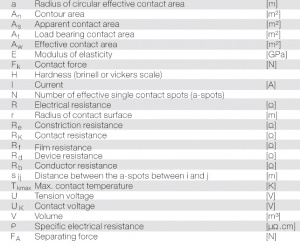Begriffe
From Electrical Contacts
Definition of Terms and Symbols
- Elektrischer Kontakt
ist ein Zustand, der durch stromführungsfähige Berührung zweier Bauteile entsteht.
- Kontaktstück
ist ein metallisches Bauteil, das dazu bestimmt ist, den elektrischen Kontakt herbeizuführen oder aufzuheben. (Bei Wortbildungen kann auf Kontakt abgekürzt werden, wenn aus diesen eindeutig hervorgeht, dass es sich um etwas Gegenständliches handelt, z.B. Kontaktwerkstoff, Kontaktniet, Ruhekontakt).
- Kontaktfläche
ist die gesamte zur Kontaktgabe bestimmte Fläche an Kontaktstücken.
- Scheinbare Kontaktfläche As
ist der Teil der zur Kontaktgabe bestimmten Fläche an Kontaktstücken, in dem während des Zusammendrückens eine Berührung auftreten kann.
- Tragende Kontaktfläche At
ist der Teil der scheinbaren Kontaktfläche, an dem die Kontaktkraft wirksam ist. Sie setzt sich zusammen aus der Summe aller mikroskopisch kleinen Berührungsflächen.
- Wirksame Kontaktfläche Aw
ist der Teil der tragenden Kontaktfläche, in dem die Stromleitung stattfindet und die somit die Summe aller stromführungsfähigen Berührungsflächen darstellt, Aw < At < As.
- Konturfläche An
ist die zusammenhängende Fläche, die alle wirksamen Einzelflächen umschließt, Aw < An < As ; An ≠ At.
- Kontaktwiderstand Rk
setzt sich aus Engewiderstand und Fremdschichtwiderstand zusammen.
- Engewiderstand Re
ist der zusätzliche Widerstand, der sich aufgrund der Einengung der Stromfäden an der Berührungsstelle ergibt.
- Fremdschichtwiderstand Rf
wird durch eine Fremdschicht hervorgerufen, die z.B. durch Reaktion der Kontaktoberfläche mit der Umgebungsatmosphäre entsteht. (Fremdschicht ist eine Substanz auf der Kontaktoberfläche, die sich in ihren Eigenschaften von dem für das Kontaktstück gewählten Werkstoff unterscheidet).
- Durchgangswiderstand Rd
wird bestimmt zwischen Bezugspunkten, vorzugsweise den Anschlussstellen, die frei gewählt werden können, jedoch angegeben werden müssen. Er setzt sich zusammen aus dem Bahnwiderstand Rb der Kontaktteile und dem Kontaktwiderstand Rk
- Contact force Fk
is the force that is exerted between the two contact parts in the closed position.
- Frictional wear
is the loss of material caused by mechanical wear between contact parts.
- Bounce
is the single or multiple interruption of conduction between contact parts during the make operation caused by alternating transformation of kinetic to potential energy.
- Contact wear
includes all changes on a contact surface. Mechanical and electrical wear must be distinguished.
- Material transfer
is the transfer of contact material from one contact part to the other. It occurs mainly during switching of DC loads. The direction of the transfer depends on the load circuit properties and the contact materials used.
- Arc erosion
is the loss of material into the surrounding of the contact spot which is generated by electrical arcing. It occurs during contact make as well as break operations.
- Contact welding
occurs when melt-liquefied touching areas of the contact parts come in contact with each other. The melting occurs during high current carrying through these areas. During make operations this occurs through bounce arcs, on closed contacts a too high contact resistance or dynamic separation of the contacts due to high short circuit currents can cause the welding of the contacts. The welding then may cause a device failure if the device specific opening forces cannot break the weld connection.
- Arc movement
happens when during the break operation a sufficiently high magnetic field is generated which exerts a force on the electrical arc which is then moved from the originating spot towards an arc chute (or arc splitting plates).
- Arc extinguishing
means the process of letting the current go to zero and transferring the arcing gap from a conducting to the non-conducting stage. Selecting the most effective extinguishing measures depend mostly on the current characteristics, the current value and the circuit voltage.
- Recovery
of an arc gap during contact opening is defined as the process of the electrically conducting plasma of an arc losing its electrical conductivity after reaching current-zero.
- Symbole used
Figure 1

